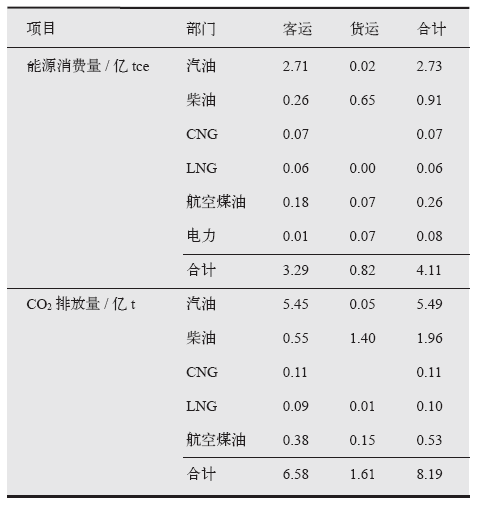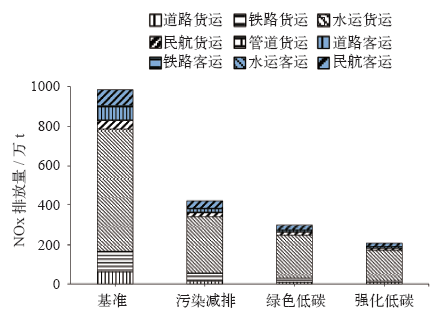Climate Change Research ›› 2021, Vol. 17 ›› Issue (3): 279-288.doi: 10.12006/j.issn.1673-1719.2020.214
• Pollutants and GHGs reduction synergy to enhance efficiency • Previous Articles Next Articles
Simulation research on co-controlling pollutants and greenhouse gases emission in China's transportation sector
FENG Xiang-Zhao1( ), ZHAO Meng-Xue1(
), ZHAO Meng-Xue1( ), WANG Min1, DU Xiao-Lin1, TIAN Chun-Xiu1, GAO Ji2
), WANG Min1, DU Xiao-Lin1, TIAN Chun-Xiu1, GAO Ji2
- 1 Policy Research Center of Environment and Economy, Ministry of Ecology and Environment, Beijing 100029, China
2 Environment Defense Fund, Beijing 100007, China
-
Received:2020-09-15Revised:2020-12-02Online:2021-05-30Published:2021-06-01 -
Contact:ZHAO Meng-Xue E-mail:feng.xiangzhao@prcee.org;zhao.mengxue@prcee.org
Cite this article
FENG Xiang-Zhao, ZHAO Meng-Xue, WANG Min, DU Xiao-Lin, TIAN Chun-Xiu, GAO Ji. Simulation research on co-controlling pollutants and greenhouse gases emission in China's transportation sector[J]. Climate Change Research, 2021, 17(3): 279-288.
share this article
Add to citation manager EndNote|Ris|BibTeX
URL: http://www.climatechange.cn/EN/10.12006/j.issn.1673-1719.2020.214
| [1] | 冯相昭, 蔡博峰. 中国道路交通系统的碳减排政策综述[J]. 中国人口?资源与环境, 2012,22(8):10-15. |
| Feng X Z, Cai B F. A review on policies of reducing carbon emission in China's urban road transport system[J]. China Population, Resources and Environment, 2012,22(8):10-15 (in Chinese) | |
| [2] | 李玮, 孙文. 省域交通运输业碳排放时空分布特征[J]. 系统工程, 2016,34(11):30-38. |
| Li W, Sun W. Spatial and temporal distribution characteristics of carbon emission in provincial transportation industry[J]. Systems Engineering, 2016,34(11):30-38 (in Chinese) | |
| [3] | 白静. 中国基础设施隐含碳时空变化特征及驱动因素研究[D]. 兰州: 兰州大学, 2019. |
| Bai J. Study on temporal and spatial variation characteristics and driving factors of embodied carbon emissions in China's infrastructure[D]. Lanzhou: Lanzhou University, 2019 (in Chinese) | |
| [4] | 卢升荣, 蒋惠园, 刘瑶. 交通运输业 CO2 排放区域差异及影响因素[J]. 交通运输系统工程与信息, 2017,17(1):32-39. |
| Lu S R, Jiang H Y, Liu Y. Regional disparities and influencing factors of CO2 emission in transportation industry[J]. Journal of Transportation Systems Engineering and Information Technology, 2017,17(1):32-39 (in Chinese) | |
| [5] | 范育洁, 曲建升, 张洪芬, 等. 西北五省区交通碳排放现状及影响因素研究[J]. 生态经济, 2019,35(9):32-37, 67. |
| Fan Y J, Qu J S, Zhang H F, et al. Study on the current situation and influence factors of transportation carbon emissions in five Northwest provinces[J]. Ecological Economy, 2019,35(9):32-37, 67 (in Chinese) | |
| [6] | 景美婷. 京津冀区域交通运输业碳排放驱动因子分解及预测研究[D]. 天津: 天津理工大学, 2019. |
| Jing M T. Research on carbon emission prediction and factor decomposition of transportation industry in Beijing-Tianjin-Hebei region[D]. Tianjin: Tianjin University of Technology, 2019 (in Chinese) | |
| [7] | 陈亮, 王金泓, 何涛, 等. 基于SVR 的区域交通碳排放预测研究[J]. 交通运输系统工程与信息, 2018,18(2):13-19. |
| Chen L, Wang J H, He T, et al. Forecast study of regional transportation carbon emissions based on SVR[J]. Journal of Transportation Systems Engineering and Information Technology, 2018,18(2):13-19 (in Chinese) | |
| [8] | 吴潇萌. 中国道路机动车空气污染物与CO2排放协同控制策略研究[D]. 北京: 清华大学, 2016. |
| Wu X M. Integrated emission mitigation strategies of air pollutants and CO2 for on-road vehicles in China[D]. Beijing: Tsinghua University, 2016 (in Chinese) | |
| [9] | 谭琦璐, 杨宏伟. 京津冀交通控制温室气体和污染物的协同效应分析[J]. 中国能源, 2017,39(4):25-31. |
| Tan Q L, Yang H W. Traffic control of greenhouse gases and pollutants and its synergistic effect analysis in Beijing-Tianjin-Hebei region[J]. Energy of China, 2017,39(4):25-31 (in Chinese) | |
| [10] | 池莉. 基于LEAP模型的北京市未来客运交通能源需求和污染物排放预测[D]. 北京: 北京交通大学, 2014. |
| Chi L. The prediction of Beijing passenger traffic energy demand and pollutants emission in future based on LEAP model[D]. Beijing: Beijing Jiaotong University, 2014 (in Chinese) | |
| [11] | 于灏, 杨瑞广, 张跃军, 等. 城市客运交通能源需求与环境排放研究: 以北京为例[J]. 北京理工大学学报: 社会科学版, 2013 (5):10-15. |
| Yu H, Yang R G, Zhang Y J, et al. Study on the energy demand and environmental emissions of urban transport: a case study of Beijing[J]. Journal of Beijing Institute of Technology: Social Sciences Edition, 2013 (5):10-15 (in Chinese) | |
| [12] | 周健, 崔胜辉, 林剑艺, 等. 基于LEAP 模型的厦门交通能耗及大气污染物排放分析[J]. 环境科学与技术, 2011 (11):164-170. |
| Zhou J, Cui S H, Lin J Y, et al. LEAP based analysis of transport energy consumption and air pollutants emission in Xiamen city[J]. Environmental Science and Technology, 2011 (11):164-170 (in Chinese) | |
| [13] | 朱跃中. 中国交通运输部门中长期能源发展与碳排放情景设计及其结果分析(一)[J]. 中国能源, 2001 (11):25-27. |
| Zhu Y Z. Medium and long-term energy development and carbon emission scenario design in China's transport sector analysis results (I)[J]. Energy of China, 2001 (11):25-27 (in Chinese) | |
| [14] | 董蕾. 基于LEAP模型的四川省交通运输业能源消费趋势研究[D]. 四川: 四川省社会科学院, 2016. |
| Dong L. Research on energy consumption trend of Sichuan transportation industry based on LEAP model[D]. Sichuan: Sichuan Academy of Social Sciences, 2016 (in Chinese) | |
| [15] |
Yan X, Crookes R J. Reduction potentials of energy demand and GHG emissions in China's road transport sector[J]. Energy Policy, 2009,37(2):658-668
doi: 10.1016/j.enpol.2008.10.008 URL |
| [16] | 潘鹏飞. 基于LEAP 模型的河南省交通运输节能减排潜力分析[D]. 河南: 河南农业大学, 2014. |
| Pan P F. Analysis of the energy-saving and emission-reduction potential for transportation in Henan province based on LEAP[D]. Henan: Henan Agricultural University, 2014 (in Chinese) | |
| [17] | 吴玉婷, 王晓荣, 何潇蓉. 基于LEAP模型的北京市交通能耗及环境污染排放预测[J]. 河北建筑工程学院学报, 2018,36(4):85-90, 110. |
| Wu Y T, Wang X R, He X R. Forecast of traffic energy consumption and environmental pollution emission in Beijing based on LEAP model[J]. Journal of Hebei Institute of Architecture and Civil Engineering, 2018,36(4):85-90, 110 (in Chinese) | |
| [18] | Peng B, Du H, Ma S, et al. Urban passenger transport energy saving and emission reduction potential: a case study for Tianjin, China[J]. Energy Conversion & Management, 2015,102:4-16 |
| [19] | 黄成, 陈长虹, 王冰妍, 等. 城市交通出行方式对能源与环境的影响[J]. 公路交通科技, 2005,22(11):163-166. |
| Huang C, Chen C H, Wang B Y, et al. Urban travel modal split and its impact on energy and environment[J]. Journal of Highway and Transportation Research and Development, 2005,22(11):163-166 (in Chinese) | |
| [20] |
He L Y, Chen Y. Thou shalt drive electric and hybrid vehicles: scenario analysis on energy saving and emission mitigation for road transportation sector in China[J]. Transport Policy, 2013,25:30-40
doi: 10.1016/j.tranpol.2012.11.006 URL |
| [21] | 朱松丽. 私人汽车拥有率预测模型综述[J]. 中国能源, 2005,27(10):37-40. |
| Zhu S L. A survey of predictive models for private car ownership[J]. Energy of China, 2005,27(10):37-40 (in Chinese) | |
| [22] | 王旖旎. 中国汽车需求预测: 基于Gompertz模型的分析[J]. 财经问题研究, 2005,29(11):42-50. |
| Wang Y N. Car ownership forecast in China: an analysis based on Gompertz equation[J]. Research on Financial and Economic Issues, 2005,29(11):42-50 (in Chinese) | |
| [23] | 李捷, 刘森. 基于Gompertz模型变换的中国乘用车保有量预测[J]. 汽车与配件, 2018 (35):68-69. |
| Li J, Liu S. Forecast of Chinese passenger car ownership transformation based on the Gompertz model[J]. Automobile & Parts, 2018 (35):68-69 (in Chinese) | |
| [24] |
Dargay J, Gately D. Vehicle ownership to 2015: implication for energy use and emissions[J]. Energy Policy, 1997,25(14):1121-1127
doi: 10.1016/S0301-4215(97)00104-3 URL |
| [25] | Dargay J, Gately D. Income's effect on car and vehicle ownership, worldwide: 1960-2015[J]. Working Papers, 1999,33(2):101-138 |
| [26] | 古继宝, 亓芳芳, 吴剑琳. 基于Gompertz模型的中国民用汽车保有量预测[J]. 技术经济, 2010,29(1):57-62. |
| Gu J B, Qi F F, Wu J L. Forecasting on China's civil automobile-owned based on Gompertz model[J]. Technology Economics, 2010,29(1):57-62 (in Chinese) | |
| [27] | 杜传祥, 魏秀岭. 基于Gompertz模型的西安市电动汽车保有量的预测研究[J]. 现代工业经济和信息化, 2018,8(3):89-90, 93. |
| Du C X, Wei X L. Research on prediction of electric vehicle quantities in Xi'an based on Gompertz model[J]. Modern Industrial Economy and Informationization, 2018,8(3):89-90, 93 (in Chinese) | |
| [28] | 刘俊伶, 孙一赫, 王克, 等. 中国交通部门中长期低碳发展路径研究[J]. 气候变化研究进展, 2018,14(5):513-521. |
| Liu J L, Sun Y H, Wang K, et al. Study on mid-and long-term low carbon development pathway for China's transport sector[J]. Climate Change Research, 2018,14(5):513-521 (in Chinese) |
| Viewed | ||||||
|
Full text |
|
|||||
|
Abstract |
|
|||||










